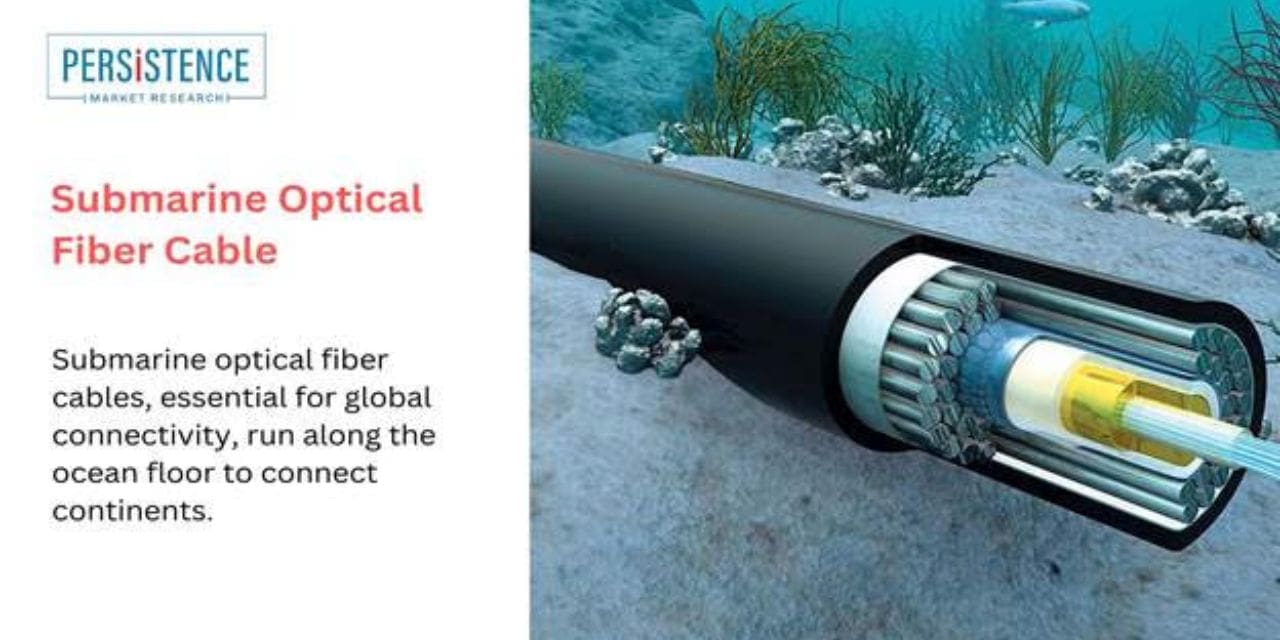Market Overview:
The submarine optical fiber cable market is a crucial segment of the global telecommunications industry. These specialized cables are laid on the seabed to connect continents, enabling high-speed data transmission, supporting internet connectivity, international phone calls, and data exchange for various industries. The market has experienced substantial growth due to increasing demand for high-capacity and low-latency communication. Key players are investing in advanced submarine cable systems to meet this demand. Factors like the proliferation of internet usage, cloud computing, and the need for reliable regional connectivity continue to drive expansion in the submarine optical fiber cable market.
The global submarine optical fiber cable industry size is anticipated to reach US$ 67.8 billion in 2033. It is set to exhibit a CAGR of around 12.6% in the estimated time frame between 2023 and 2033. The market is likely to surpass a valuation of US$ 20.6 billion by 2023 by Persistence Market Research
Submarine Optical Fiber Cables (SOFCs) are the lifelines of global connectivity, lying on the ocean floor to interconnect continents. These high-capacity cables enable lightning-fast data transmission, underpinning the internet, international phone calls, and data transfer for various industries. SOFCs are engineered for reliability and resilience, protected against underwater environmental factors and potential disruptions. They contribute significantly to global commerce, research collaboration, and emergency communication. As data demands surge, the industry continually expands and upgrades its infrastructure. SOFCs are essential for sustaining our digitally connected world, supporting economic growth, and shaping the future of international communication.
Market Growth Factors:
Several key factors are driving the growth of the submarine optical fiber cable market. Firstly, the increasing demand for high-speed internet services, driven by the proliferation of online activities, remote work, and digitalization, fuels the need for robust undersea connectivity. Secondly, the rise of cloud computing and data centers necessitates high-capacity, low-latency communication links across continents. Additionally, the global demand for reliable and secure data for industries such as finance, healthcare, and content delivery amplifies market growth. Lastly, investments by major tech companies and telecom operators in expanding and upgrading transmission submarine cable networks contribute significantly to the market’s expansion.
Market Opportunities:
The Submarine Optical Fiber Cable (SOFC) market is brimming with opportunities in the rapidly evolving landscape of global connectivity. The surge in digitalization and data-driven technologies has created an unprecedented demand for high-speed and reliable data transmission across borders. One of the primary opportunities lies in addressing this escalating data appetite by developing advanced SOFC systems with higher capacity and enhanced reliability. Emerging markets, where internet penetration is still expanding, offer a substantial growth frontier, as there is a pressing need to connect these regions with the rest of the world.
Market Trends:
The Submarine Optical Fiber Cable (SOFC) market is currently characterized by several prominent trends that are shaping the future of global connectivity. One of the most significant trends is the relentless drive for capacity expansion, as the insatiable demand for high-speed data transmission continues to surge. Cable providers are investing in cutting-edge technologies to deploy systems with higher capacity, ensuring they can meet the escalating bandwidth requirements of our digital age. Additionally, there is a growing emphasis on data security, with advanced encryption and cybersecurity measures being integrated into SOFC systems to protect sensitive information during transmission.
Environmental sustainability is another crucial trend, with a focus on eco-friendly installation techniques and materials to minimize the impact on marine ecosystems. Collaborative efforts through consortiums and partnerships are on the rise, allowing shared investments in cable infrastructure for long-distance connections. Moreover, the development of cable landing stations is becoming more common, facilitating seamless connections between submarine cables and terrestrial networks. These trends collectively reflect the industry’s commitment to meeting the evolving needs of global communication while ensuring reliability, security, and sustainability in an increasingly interconnected world.
Market Challenges:
The Submarine Optical Fiber Cable (SOFC) market confronts significant challenges. These include substantial capital requirements for system development and maintenance, making projects susceptible to economic uncertainties. The vulnerability of undersea cables to physical damage from ship anchors, natural disasters, and fishing activities necessitates robust protection measures. Data security is paramount, demanding advanced encryption to safeguard sensitive transmissions. Environmental concerns center on potential disruption to marine ecosystems during cable installation. Additionally, geopolitical tensions and national interests may disrupt international connectivity by imposing restrictions on submarine cable infrastructure. Overcoming these challenges is crucial to ensuring the reliability and continued growth of the SOFC market.

